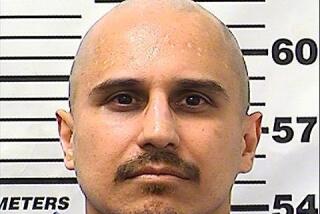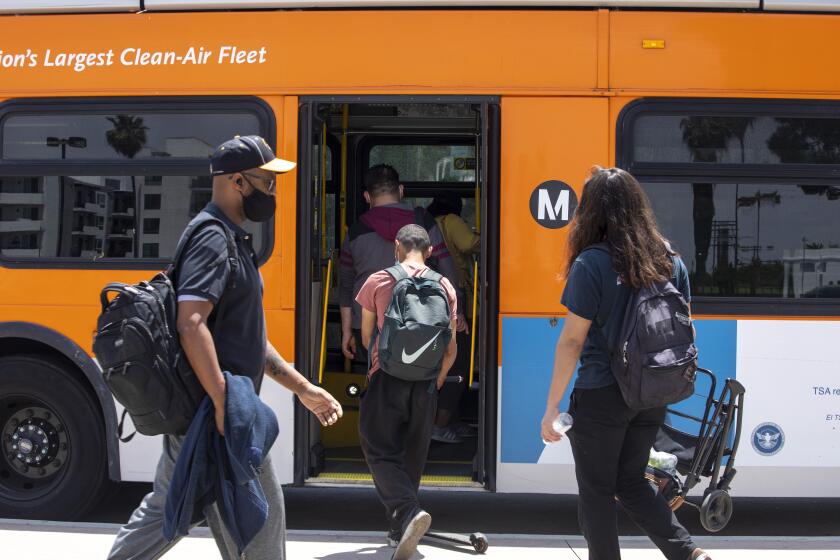SCAT Buses Getting More Costly and Complicated : Transit: Beginning Monday, regular fares will jump from 75 cents to $1, and drivers will no longer make change.
Beginning Monday, riding a South Coast Area Transit bus will become more expensive and more complicated for Janet Wright, a Port Hueneme resident.
Her bus fare will jump from 75 cents to $1, and the drivers will no longer make change.
“That will be a problem,” said Wright. “I don’t always have a dollar bill with me. Sometimes I just have a five.”
But bus driver Mary Taylor, who believes the change she carries is a tempting target for robbers, says her job will become less dangerous.
“It’s great!” said Taylor. “I don’t have to carry money now. Have you looked at the economy lately? Wouldn’t someone like to hit you for $100?”
Ventura County’s largest bus agency, widely known as SCAT, is bracing for mixed reactions and confusion at the fare box as it alters two long-standing policies.
SCAT’s fares have remained the same for 11 years. And since the system was founded 20 years ago, SCAT drivers have always made change.
The agency, which serves Ventura, Oxnard, Port Hueneme, Santa Paula, Ojai and nearby areas, recorded more than three million passenger boardings last year.
Despite placards, fliers and advertisements heralding the price hike and exact-fare policy, SCAT administrators fear that many riders will be caught unprepared.
“We figure that during this first week, our drivers will be very busy explaining this,” said Maureen Hooper Lopez, SCAT’s director of planning and marketing. “It’s going to be a grueling week.”
For one thing, bus drivers will have to teach their passengers the fine art of folding dollar bills--and how to attach jumbo paper clips to them.
In the past, riders were required to change their paper currency to coins before depositing their fare.
Under the new policy, passengers can put paper money in the fare boxes, but only after folding it twice to fit the slot and attaching a paper clip to give it more weight.
Without the clips, SCAT officials fear the paper money will clog the fare slot or fail to fall properly into the vault.
Although SCAT drivers will no longer carry change, each will carry a pack filled with the jumbo clips.
“They’ll hand the clips to the passengers,” Lopez said. “Hopefully, people will learn very quickly--or bring quarters.”
She said SCAT administrators concluded it would be too expensive to replace all fare boxes with models that more easily accept dollar bills.
Passengers who board with only $2 or $5 bills will be able to deposit them and obtain a receipt from the driver. Passengers can turn in these receipts later at SCAT headquarters to get their change.
Before this week, SCAT was one of the last major bus systems in the nation whose drivers still made change.
Diana Bordelon, a SCAT driver for more than five years, said she is delighted to give up that distinction.
Bordelon said the continued use of a four-barrel metal change maker injured her hand, forcing her to miss 14 months of work. Most recently, she said, doctors had to remove a tendon from her right thumb, replace it with a tendon from her arm and secure it with five pins.
“It was caused by the repetitive motion of my thumb,” she said. “It was caused by making change.”
SCAT administrators confirmed that a number of drivers have suffered hand and wrist injuries from change-making.
Bordelon and other drivers have asserted that change-making at each bus stop often puts them behind schedule. They also have complained about the condition of the currency that drivers must handle on occasion.
“Sometimes, people would hand you money that they’ve had in their mouth or in their sock,” Bordelon recalled. “It was disgusting.”
Although several drivers said last week that they were worried about being robbed, SCAT administrators said no driver has been the victim of an armed holdup in the history of the system. On one occasion, however, a thief grabbed cash out of a driver’s pocket and fled.
Nevertheless, SCAT drivers, who today number about 60, have long lobbied to drop their change-making duties.
“This union took over representation of the SCAT drivers more than 10 years ago, and this has been a bargaining issue ever since,” said Larry Wear, associate director of Service Employees International Union, Local 998.
SCAT’s directors resisted until last April, when they were considering the fare increase. When they raised the regular adult fare to an even dollar, the directors also agreed to abandon change-making.
Bus fares cover only about 24% of SCAT’s $6-million annual operating costs. The system receives some state and federal funds, but about $3 million comes from the county and the five cities it serves.
Because those local costs have been rising, Ventura and Oxnard, which receive the most service and pay the lion’s share, pressured SCAT to raise its fares.
At the end of the 1993-94 fiscal year, the bus agency has agreed to refund to the county and the cities any surplus money generated by the price increase.
Students fares, for ages 5 to 20, will rise from 60 to 75 cents. For seniors, age 65 and older, and handicapped riders, the fare will increase from 30 to 50 cents.
Significant discounts are available, however, to riders who buy monthly passes and multi-ride tickets.
After SCAT’s last fare increase in 1982, accompanied by cuts in service, ridership plummeted by more than half a million boardings annually.
But few riders protested at this year’s fare hearing, and SCAT officials say they’ve fielded few complaints since then. On Friday, the system discontinued one route serving Oxnard beaches, but it is extending the service hours on several other routes.
At the Oxnard Transportation Center earlier this week, several SCAT riders said they were unaware of the imminent fare hike and exact-change policy.
Duane Hendrix, a supermarket employee who lives in Port Hueneme, said the fare hike would not pose a financial hardship to him. But he added, “I don’t think it’s fair to the community, especially the people who are less fortunate and have to rely on public transportation.”
Alvaro Rodriguez, a college student who lives in Oxnard, said the fare increase was unwarranted. “It’s not adequate service,” he said. “They cut off the buses at about 6 p.m. They should at least extend it till 9.”
Katie Ellis of Oxnard, who rides the bus to a gym for workouts, greeted news of the fare hike with a sigh of resignation. “I don’t particularly care for it,” she said. “But I’m surprised it hasn’t gone up sooner.”
More to Read
Start your day right
Sign up for Essential California for news, features and recommendations from the L.A. Times and beyond in your inbox six days a week.
You may occasionally receive promotional content from the Los Angeles Times.






